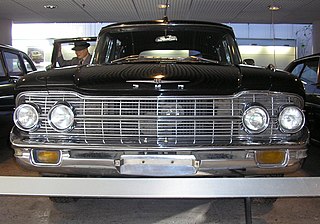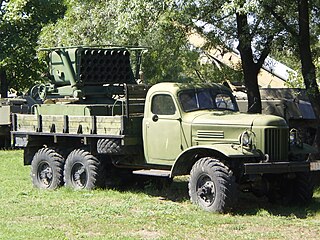 W
WThe ZiL-111 was a limousine produced by the Soviet car manufacturer ZiL in 1958–1967. It was the first post-war limousine designed in the Soviet Union. After tests with the shortlived prototype ZIL-Moscow in 1956, which gained a place in the Guinness Book of Records as the largest passenger car in the world, the ZIL-111 was introduced from ZIL in 1958. The body style was in the American tradition of the time and resembled the mid-1950s cars built by Packard, although, apart from being in tune with current trends, it was an original design and had nothing in common with them, except in general layout. The interiors were trimmed with top quality leather and broadcloth and decorated with thick pile carpet and polished wooden fittings. It featured a comprehensive ventilation and heating system and a 5-band radio, all of which could be controlled from the rear, electric windows, vacuum-operated screen wash, windshield and front door window defrosting. It was powered by a 6.0 L V8 engine producing 200 hp connected to an automatic transmission giving a top speed of 170 km/h (106 mph), hydraulic drum brakes with a vacuum servo booster, coil and wishbone IFS. The car won a top prize at the Brussels Expo World Fair in 1958.
 W
WThe ZIL-112 Sports was a Soviet sports car made by ZiL car manufacturer in 1961 and competed in races from 1961 to 1969. Two cars were built. The 112S initiated a number of firsts for cars produced in the USSR such as controlled slip differential, disc brakes, radial-ply tires etc. One ZiL-112S was powered by a 6.0 L V8 with 230 hp (172 kW). A second ZiL-112S was equipped with a 270 hp (201 kW) 7.0 L V8. Both engines were developed from the ZIS-110 engine. Depending on the engine, the top speed was 260–270 km/h (160–170 mph). It could do 0–100 km/h in 9 seconds. The total weight was 1,330 kg (2,932 lb). Steering and front suspension came from the GAZ M21 Volga. In the rear, it used De Dion suspension with triangular levers. The transmission, like the engine, was from the ZIS-110.
 W
WThe ZIL-114 is a limousine from the Soviet car manufacturer ZIL introduced in 1970 to replace the ZIL-111 series which was gradually becoming out of date. In almost all respects, the ZIL-114 improved on the 111, 111A and 111G models. The engine, a ZIL-built pushrod V8, was increased in capacity from 5,980 cc (364.9 cu in) to 6,959 cc (424.7 cu in), resulting in an increase of power by 30 percent and of maximum speed from approximately 170 km/h (110 mph) to 200 km/h (120 mph). Transmission was two-speed automatic, with hydraulic torque converter. A three-speed gearbox was offered beginning in April 1975.
 W
WThe ZIS-115 is a Soviet built armored version of the ZIS-110 limousine, designed and built especially for Joseph Stalin. 32 of the cars were manufactured between 1948-49. The heavily armored car's design was based on the American 1942 Packard Super Eight. The car weighed over 4 tons, windows made of glass nearly 3 inches thick were powered by a hydraulic system. Its 6.0-liter straight-eight engine generated 162 horsepower with a top speed of 75 mph. Stalin, extremely paranoid of assassination, always rode in the rear of the car, seated between two armed bodyguards. He never rode in the same armored ZIS two days in a row, and frequently changed the route driven from his home in Kuntsevo to the Kremlin. After Stalin's death in 1953, the armored ZIS limousines continued to be used for many years by successive Soviet leaders. Today, several of the cars are owned by private collectors and museums around the world.
 W
WThe ZIL-117 is a luxury sedan built by ZiL in USSR and first presented at the Autoprom in 1977. Debuting in 1971, it was derived from the earlier ZIL-114.
 W
WThe ZiL-118 Yunost (Youth) was a microbus built by Zavod imeni Likhachova, or ZiL.
 W
WThe ZiL-130 is a Soviet/Russian truck produced by ZiL in Moscow, Russia. The first prototype was built in 1956. Production began in 1962, while mass production started in 1964. It was one of the most numerous cargo trucks in the USSR and Russia, in total ZIL built 3,380,000 trucks up to 1994. In 1995, production was moved to the now-defunct Ural Motor Plant.
 W
WThe ZIL-131 is a general purpose 3.5 tons 6x6 army truck designed in the Soviet Union by ZIL. The basic model being a general cargo truck. Variants include a tractor-trailer truck, a dump truck, a fuel truck, and a 6x6 for towing a 4-wheeled powered trailer. The ZIL-131 also serves as a platform for the 9P138 rocket launcher, a 30-tube variant of the BM-21 "Grad".
 W
WThe ZIL-4104 was a limousine built by ZiL from the late 1970s to the early 1980s, when it served as the transport of the elite of the Soviet Union. It is estimated that no more than fifty cars were produced each year.
 W
WThe ZIL-4112 is a luxury car with a limousine body type built by ZIL of Russia.
 W
WThe ZIL-41047 is a limousine built by ZIL of Russia. Production of ZIL models ceased in 2002 due to their previous customer base turning to more modern Western vehicles. Some last ones were built before year 2017.
 W
WThe BTR-152 was a six-wheeled Soviet armored personnel carrier, built on the chassis and drive train of a ZiS-151 utility truck. It entered service with a number of Warsaw Pact member states beginning in 1950, and formed the mainstay of Soviet motor rifle battalions until the advent of the amphibious BTR-60 series during the 1960s.
 W
WThe ZIL-135 is a large, eight-wheeled military transport and self-propelled artillery truck produced in the Cold War by the Soviet Union starting in 1959. Its purpose was to carry and launch an artillery missile, specifically a FROG-7, from surface-to-surface. The ZIL-135 was widely exported to other communist countries, most notably North Korea, where it is a common sight in films and military marches. It also served as the TEL for the BM-27 Uragan artillery rocket system.
 W
WThe ZIL-157 is a general purpose 2 1⁄2-ton 6x6 truck, produced post-World War II in the Soviet Union by ZiL.
 W
WThe ZIL-2906 or ZIL-29061 is a screw-driven amphibious craft from the Russian ZiL vehicle manufacturer.
 W
WThe ZIL-E-167 is an off-road truck designed in the beginning of the 1960s to withstand difficult conditions in Siberia, Urals and far east and northern territories of the Soviet Union. It could cross water and control its tire pressure, and was equipped with air cleaning systems as well as a 4.5 kW electric engine to pump water. It also had radio transmission capabilities.
 W
WThe ZIS-5 was a 4x2 Soviet truck produced by Moscow ZIS factory from 1932 to 1948.
 W
WThe ZIS-6 is a Soviet general purpose 6×4 army cargo truck, a three-axle version of the ZIS-5 two-axle truck. It was built from 1933 until October 1941 at the Moscow Zavod imeni Stalina factory and reached a total production of 21,239.
 W
WThe ZIS-101 was a limousine produced by the Soviet car manufacturer Zavod Imeni Stalina. It was introduced in 1936 and was equipped with an 5.8 L (354 cu in) straight-8 engine producing 90 hp (67 kW) and giving a top speed of 115 km/h (71 mph). The car was fitted with a 3-speed manual gearbox.
 W
WThe ZIS-110 was a Soviet limousine from ZIL introduced in 1946.
 W
WThe ZIS-150 was a Soviet truck. In 1947 it replaced the ZiS-5 truck on assembly line. ZIS-150 together with GAZ-51 was the main Soviet truck of the 1950s, judging by their quantity. A tractor-trailer version of the ZIS-150, the ZIS-120N was sold from 1956–1957. In 1957, the base ZIS-150 model was replaced by ZIL-164, which differed outwardly only by vertical grille bars and bumper. ZIS-150 was also manufactured in Braşov, Romania between 1954-1960 as the "Steagul Rosu" SR-101 and in China as the Jie Fang CA-10 at First Automobile Works. At least one prototype was built in North Korea under the name "Chollima".
 W
WThe ZiS-151 was a general-purpose truck produced by the Soviet car manufacturer Automotive Factory No. 2 Zavod imeni Stalina in 1947–1958. In 1956, the factory was renamed to Zavod imeni Likhacheva, and new trucks were called ZiL-151 (ЗиЛ-151).